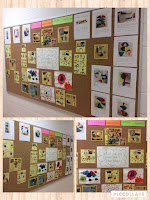In the Kindergarten program, learning in the outdoors is included as part of the instructional day, and the educators play an active role, engaging with children in an inquiry stance as they play, explore, and learn together outside the classroom”
(Ontario Kindergarten Program, 2016, p. 34).
What curriculum document do you turn to for outdoor learning in kindergarten?http://www.edugains.ca/resourcesCurrImpl/OntCurriculum/kindergarten_english.pdf
The Ministry of Education provides educators with a document based on outdoor education allowing educators to plan based on the outdoor curriculum. An example from the Outdoor Education Kindergarten Curriculum V2.1 Explore a variety of tools, materials, and processes of their own choice to create visual art forms in familiar and new ways is a success criteria that fits with a provocation i had set up called nature painting.
What are the benefits of outdoor learning? Why should we take our students outside and expand our classroom and open up new wonders and inquires? Children are happier, more active, less stressed, they are more creative and finally relaxed and calm. The benefits outweigh the negatives when it comes to outdoor learning.
The many difficulty educators have about bringing their learning beyond the classroom and in to the outdoors is how plan based on the curriculum. The outdoors have potential to go cross all the curriculum categories and can cover each category. It all starts with a nature walk beyond the fence of your school and see what the children find and collect. Nature scavenger hunts will allow the children to go out and find matures they can bring into the classroom and explore in the centres that already are there and the centres they can create. Setting up tree sticks, rocks, leaves, flowers, etc could be used as math manipulatives, art materials, and other wonders the children may see within the materials.
Children books that can help you introduce outdoor learning in your classroom
- The Listing Walk By: Paul Showers
- Not A Stick by Antoinette Portis
- If You Hold a Seed by Elly MacKay
Outdoor education can be as easy as bringing your materials from the inside of your classroom outside and create outdoor centres that children can play and create. The change of background may take effect on how the children play and the stories they create. Nature materials can be used as loose parts for the children to explore with.
During the school year I was lucky enough to join the YRDSB early years team at the Beyond on the fence workshop 2016. During the workshop I was able to facilitate “Art of Nature” with KindieKorner and Educate.Invest.InspireArt of nature was a way to show other educators how to incorporate the art curriculum out in nature. Painting with found artifacts in nature, finding a sit spot and drawing what you see in nature, and painting rocks are examples of a few of the many different activities that can be done to take your children outdoor and enjoy the learning beyond the classroom.

For more great information about the wonders of outdoor education please visit Trista Dutt of Kindie Korner and Rose Marcelli of Educate.Invest.Inspire






